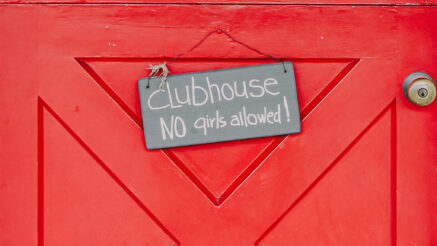Public school in America starts when the kid is five years old, but gender and sex education should begin when the child starts understanding the concept of gender identity which can be as early as 18 months old! So let’s talk about what topics are age appropriate and why.
The guide below is the recommended age to introduce each topic. Learning is ongoing, it may take a kid years to understand the topic, and neurodivergent children may not fully grasp a concept as early as their neurotypical peers. You also know your child best, they might not be ready at the recommended age either.
If your child’s school isn’t providing this education early enough or you’re opting out to teach your child this content at home, consider this a pocket guide for your syllabus!
Birth to 1 Year
Use correct names for genitals
Studies show that kids who use the correct anatomical words like penis, scrotum, vulva, and clitoris enhances their body image, self-confidence, and openness. It also reduces their susceptibility to predators and in the event that they are sexually abused, having the correct language helps.
Sources & References
- Dona Matthews, Ph.D., “Call Children’s Private Body Parts What They Are” (Mar. 6, 2017). Psychology Today.
1 – 2 Years
The concept of consent
Learning how to say no is also a challenge for adults and it’s often because they never had autonomy as children. Help your child have a healthy relationship with the word “no” and “stop” by allowing them to set that boundary and then respect it. Teaching this vital skill can empower them to protect themselves when you’re not there.
Resources
- The Healthy Sex Talk: Teaching Kids Consent, Ages 1-21
- How to Teach Your Child About Consent From Birth
- Teaching Consent to Toddlers – what it looks like in our home
- C is for Consent board book for kids to say no to hugs and kisses, and that what happens to a their body is up to them
- Baby Knows Best: Raising a Confident and Resourceful Child the RIE™ Way – a book for adults on raising self-confident, self-reliant children using the RIE (Resources for Infant Educarers) approach
Bodies do not determine gender
After having learned the name of each body part, including genitals, it’s important to remind children that bodies do not indicate gender. Breasts and vulvas are not exclusive to women; those that aren’t women have them too. Penises and scrotums are not exclusive to men; those that aren’t men have them too. Don’t assume someone’s gender based on their appearance. That’s it. That’s the whole lesson.
Sources & References
- Jason Rafferty, MD, MPH, EdM. FAAP, “Gender Identity Development in Children” (Sept. 18, 2018). American Academy of Pediatrics.
2 – 3 Years
The concept of boundaries
When a child is told no, it is important they learn how to recognize that is a boundary and how to handle their possibly big feelings whether it is you saying no to ice-cream before dinner or a teenager not responding to their romantic advancements.
Resources
Gender identity options
Most kids can easily state their gender when asked, so this is where we start talking about the labels on the gender spectrum so they can tell you who they are. At this age, self-recognition is still in progress, so a kid might change their answer every time you ask.
Resources
- It Feels Good to Be Yourself: A Book About Gender Identity – a picture book that introduces the concept of gender identity to the youngest reader from writer Theresa Thorn and illustrator Noah Grigni
Sources & References
- Jason Rafferty, MD, MPH, EdM. FAAP, “Gender Identity Development in Children” (Sept. 18, 2018). American Academy of Pediatrics.
Families look all kinds of ways
Some kids have one mom and one dad. Some kids have two moms. Some kids have two dads. Some kids have three or more parents (blended families). Some kids have only one parent. Some kids have none. The topic is family diversity, not sexual orientation.
Many Disney stories, both classic and modern, have diverse families from dead parents, step parents, being raised by a sibling, etc. Seek out stories that include diverse families in a positive light (Cinderella, I’m looking at you for making step-moms and sisters look bad!). Examples might be:
- Lilo & Stitch: the titular character Lilo is being raised by her older sister
- Pete the Cat: Sally the squirrel has two dads
- Bluey: Winton’s parents are (maybe?) separated
Resources
Masturbation
Toddlers masturbate. Talk about boundaries to limit it to their alone time in the bathroom or bedroom. Talk about consent and how it makes you feel uncomfortable when they do it around you, family members, or guests.
Additionally, set a boundary to always wash hands before and after their alone time to promote hygiene and to avoid infections like a UTI.
Resources
Personal genital hygiene
When potty training starts, cover toilet hygiene such as wiping a vulva from front to back and how to clean a foreskin. At this time, only teach about the routine they need to do for their bodies, not everyone’s bodies (unless asked). That will come later. Why? Because it’s important to know how to take care of other people’s bodies, especially for those in caregiver roles such as parents, guardians, medical staff, and those working in homes for disabled or elderly.
Education on self-care should not be placed on the shoulders of just the parent who has the same genitals as the kid. If your family is fortunate enough to have more than one parent or caregiver, then it’s all of your jobs to educate as a team. E.g. dads should be just as involved in teaching their daughters how to wipe rather than remain ignorant on how to care for a vulva.
3 – 4 Years
Pronouns
Start normalizing introducing yourself to others with your pronouns and asking other people what their pronouns are. Use gender neutral pronouns until you know what someone’s pronouns are since we shouldn’t assume based on appearance.
4 – 8 Years
Gender euphoria
Guide your child with finding activities and looks that are gender affirming for them. For example, a cis/trans girl might want to play with make-up or ask to shave their legs. Encourage the things that bring them euphoria.
Sources & References
- Nova J. Bradford, G. Nic Rider, and Katherine G. Spencer, “Hair removal and psychological well-being in transfeminine adults: associations with gender dysphoria and gender euphoria” (Nov. 22, 2019). Journal of Dermatological Treatment.
- Ashley Austin, Ryan Papciak, and Lindsay Lovins, “Gender euphoria: a grounded theory explanation of experiencing gender affirmation” (Mar. 8, 2022). Psychology & Sexuality.
- Will J. Beischel, Stéphanie E. M. Gauvin, and Sari M. van Anders, “A little shiny gender breakthrough: Community understandings of gender euphoria” (May 3, 2021). International Journal of Transgender Health.
Gender dysphoria & body dysmorphia
Educate your child on both of these and keep an open connection in case they need to talk to you about it.
Keep an eye out for signs of depression because it really can start this early.
Resources
- Quick Guide to Gender Dysphoria
- What are Gender Dysphoria and Gender Euphoria?
- When You Don’t Feel at Home With Your Assigned Gender
- The Difference Between Gender Dysphoria and Body Dysmorphia
- Gender Dysphoria, Body Dysmorphia & Body Image in Trans & Non-Binary Folks
- Signs of depression in children
- Childhood Depression: What Parents Need to Know
Sources & References:
- Gender dysphoria definition by Mayo Clinic.
- Gender dysphoria definition by the NHS
Editor's Note: This article was originally published on , and was last reviewed on . This article will be updated periodically with more references and resources for the different topics.




